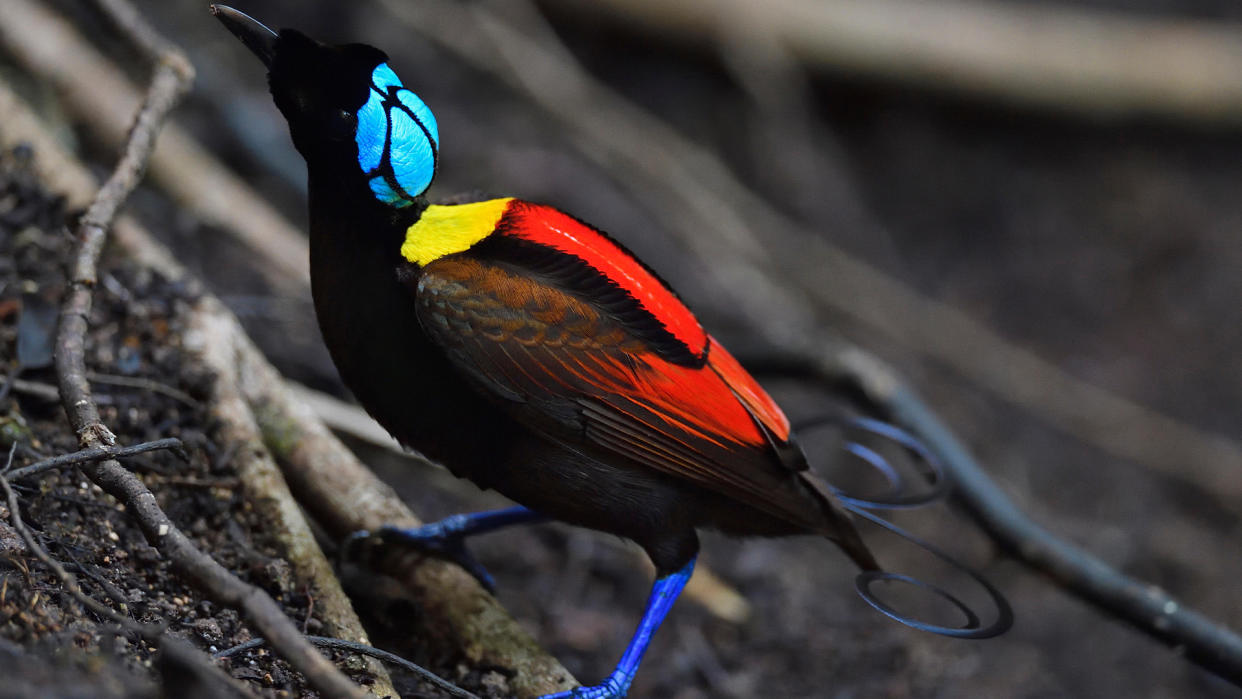Why are animals so colorful?

From the blue, yellow and red hued mandrill to the tie-dyed panther chameleon, nature hosts a parade of vibrant and gorgeous animals.
But why do animals make this broad palette of colors? And how do they do it?
Their methods are diverse, and surprising. Take the mandrill, which produces its vivid blue snout using meticulously arranged collagen fibers that reflect the light. Meanwhile, chameleons produce their shifting rainbow-tinted skin with the help of nanocrystals.
Related: How long do new species take to evolve?
Reason to be colorful
Many of these animals hold clues that could help answer the question of why such colorful displays evolved. Research published in 2022 showed that all brightly colored terrestrial vertebrate species can generally be split into two camps. In the descendants of nocturnal animals, color can communicate to predators that they are poisonous and wouldn't be a good dinner choice — a phenomenon called aposematism. This tracks with their nocturnal history, as bright colors help to frighten opportunistic predators away while these animals are sleeping and vulnerable during the day.
Meanwhile, the study found that descendants of daytime animals, such as some birds, typically use color as a way to attract mates. It's likely that "sexual signals have to evolve in species that can see those colors," said John J. Wiens, professor of ecology and evolutionary biology at the University of Arizona, who co-authored the research. "Warning signals can evolve in species that do not see colors at all — or do not even have eyes — because they are signaling to other species that can see colors, like birds and fish."
Avian extravaganzas

This importance of color in mating rituals might explain why so many bird species put on such breathtaking displays. Take the Wilson's bird of paradise (Cicinnurus respublica), which boasts reds, blues and yellows brilliant enough to be visible even on the dim forest floor. When it has the attention of a female, this bird flashes its trump card — a disk of iridescent emerald feathers that bedazzles its mate. Then there's the paradise tanager (Tangara chilensis), a bird painted almost comically in bold splotches of turquoise, red, orange and navy.
"It looks like a cartoon bird, like a stuffed toy," Vinod Saranathan, an associate professor of biological sciences at the School of Interwoven Arts and Sciences at Krea University in India, told Live Science. Most remarkable is the tanager's neon-green crown, where Saranathan and colleagues found that the feathers produce an ordered crystalline structure that reflects light to create the brilliant hue. "What this means is that the female preference for more vivid colors has selected for a crystalline structure that has evolved from disordered ones," Saranathan explained.
Diversity is key

Color also may be driven by the sheer diversity of species. "One thing that color is used for, more specifically patterns of colors, is to distinguish one species from another," Saranathan said. 'Because if you're male or female and you mate with the wrong species, that is a lost opportunity." This might explain why there's such an explosion of color in the insect family, which harbors the greatest number of species on Earth, at over 1 million.
Related: What is the most genetically diverse species?
Just take the aptly named jewel beetles (Buprestidae), whose wings are lacquered in lilac, magenta, and deep purple, iridescent blues and greens. Or the rainbow-spotted weevil (Pachyrhynchus congestus pavonius), whose wings feature circles filled with microscopic diamond-shaped crystals that increase in size, changing their relationship with the light to produce the full spectrum of blues, greens, yellows and reds, Saranathan explained. "Another example would be a Madagascan sunset moth (Chrysiridia rhipheus). It's really amazing," he said — and particularly prize-worthy, with its wings that capture the ombre shades of a sinking sun.
Not to be forgotten are spiders, like the gem-like peacock spiders (Maratus), which perform intricately choreographed dances that flaunt their festively colored abdomens to woo mates.
How animals make color
This huge diversity of color is made possible by microscopic feats of engineering. "There are really two ways: either [through] pigments, or nanostructures," Saranathan, "And sometimes there's a combination of the two."
RELATED MYSTERIES
—What is the most colorful animal?
Pigment molecules absorb light from some wavelengths, and emit the remaining wavelengths to produce specific colors. Nanoscale structures amplify the reflection of certain wavelengths to create colors, Saranathan told Live Science. The variable forms, sizes and arrangements of those nanostructures produce nearly endless possibilities. For instance, crystal-shaped nanostructures organized in a repeating pattern produce the iridescence that often adorns the wings of beetles and butterflies. Birds, meanwhile, often combine pigments with nanostructures to ultra-saturated greens, turquoises, and reds, Saranathan said.
Understanding how animals make colors can help us design more sophisticated materials, including television and phone screens, says Saranathan.
The animal kingdom provides boundless inspiration. "Everything that we think of that we can engineer, nature has already been there, done that, millions of years ago," Saranathan said. "And they're able to do it with the most basic materials that we can't even begin to fathom."

